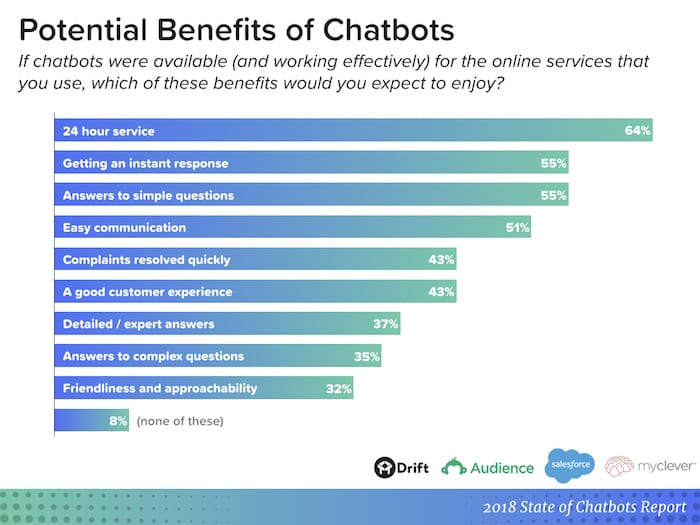~
It’s 2:30 on a sunny Friday afternoon. You’re just finishing up your day at work, a little tired and ready to bolt out of the office as soon as the clock strikes 3:00. Your computer is fading in and out of focus as you daydream about the amazing T-bones you’re going to grill up after work when suddenly you remember: it’s Mother’s Day on Sunday!
You rush online to a flower company’s website and begin scrolling through endless bouquets of tulips and snapdragons. Utterly overwhelmed by how anyone could possibly arrange the same flowers so many ways, you’re about to forfeit your spot as the favorite child and settle for a box of assorted chocolates.
Then a message pops up in the bottom corner of your screen, “Hello! Need help picking out the perfect bouquet for your mom?” Why yes, I do, you think as you begin to have a conversation about your mom’s flower preferences.
You’re walked through the selection and checkout processes until the perfect arrangement has been ordered. It is set to arrive on Monday. You’ll still be the favorite child. Success.
~
This process and many others happen every day through the up-and-coming method for communicating with customers: chatbots. There’s a lot of buzz about how they speed up customer requests and increase user satisfaction while simultaneously reducing costs for businesses. But what exactly are chatbots?
Oxford Dictionaries defines a chatbot as “a computer program designed to simulate conversation with human users, especially over the Internet.”
So, let’s have a little chat about chatbots.
Chatbots are automated messaging systems that “chat” with customers/visitors in a human manner, or “natural language”. This can occur through text or through a voice assistant, like Amazon’s Alexa or Apple’s Siri. Various forms of chatbots have been around for a while, but more sophisticated systems are being developed and implemented.
There are a variety of chatbots that use different systems to communicate and improve their processes. Simple chatbots use pre-written keywords and rules to respond to messages. Smart chatbots incorporate machine learning, Natural Language Processing (NLP), and/or artificial intelligence (AI) to carry on human-like conversations. With these methods, a system is developed and perfected to allow chatbots to understand the user’s request and intent. Then they can compose a helpful and intelligent response.
Smart chatbots will also remember past messages with individuals. This context improves the customer experience over time and increases satisfaction. The information traditionally requested through forms can now be gathered by chatbots in a conversational manner. This is extremely valuable to companies as they continue to nurture that lead.
If chatbots are unable to answer a customer’s question or complete a customer’s request, they can shift the conversation to a human associate. The chatbot will also transfer the information it has gathered. This allows for a seamless transition from bot to human. The customer doesn’t have to answer the same questions or explain the situation to the human associate, thus greatly improving the customer experience.
Advantages for Businesses and Customers
Both businesses and customers experience quite a few benefits from chatbots.
Benefits for businesses:
- Save time and human effort through automation
- Increase speed of request processing
- Improve response rate
- Increase overall productivity
- Enhance customer service and satisfaction
- Personalize communication with customers
- Automatically qualify leads into CRM
Benefits for customers:
- 24/7 customer service
- Quick responses to inquiries and timely resolutions to questions
- Answers to simple questions
- Real-time and on-demand service
Over 69% of customers report they enjoy using Chatbots to receive “quick answers to simple questions”, according to a report from Drift, SurveyMokey, Audience, Salesforce, and myclever. In fact, twilio’s Global Mobile Messaging Consumer Report showed that nearly 9 out of 10 customers would like to communicate with businesses through messaging methods such as chatbots because of this convenience.
Drift’s report outlined many other benefits that users may experience with chatbots.

The Dos and Don’ts of Chatbots
Chatbots are actively chatting away with customers all around the clock all around the world. The benefits of bots in customer service are undeniable. If you haven’t already, it’s time to hop on the chatbot train! As you look to build and implement your own chatbots, here are some simple Dos and Don’ts to keep in mind.
DO
- Use human support and intervention when needed.
- If the chatbot cannot answer the question or further assist the customer, transfer the conversation and the information over to a human.
- Start with simple questions and use short messages.
- Limit blocks of text to 150 characters or less and include response options for questions.
- Proactively open the conversation with a captivating welcome message.
- Set expectations and ask questions in the opening message.
- Give your chatbot a distinct personality.
- Name your chatbot and give it a distinct why a speaking (metaphorically, but possibly literally).
- Offer a route to exit the automated experience.
- Offer options such as “Speak to an agent” or “Something else” so the customer can opt out of the conversation to talk to a human.
DON’T
- Be shady about your process.
- Be upfront and transparent about whether the communication is with a bot or a human.
- Launch chatbots without testing.
- Create and test different types of questions and possible customer responses before implementing your chatbot. The initial launch should be to a small, select group of people.
- Leave customers aimlessly wondering through responses.
- Use CTAs to guide customers to the point of sale.
They’re here to stay. And that’s fine with us!
The benefits of chatbots for businesses and customers are evident. The automation of simple exchanges can greatly decrease human time and effort and, therefore, increase overall productivity and profit for the business. Customers have readily-available assistance and receive quick responses to their inquiries which improves their experience and increases overall satisfaction.
Thanks chatbots.





